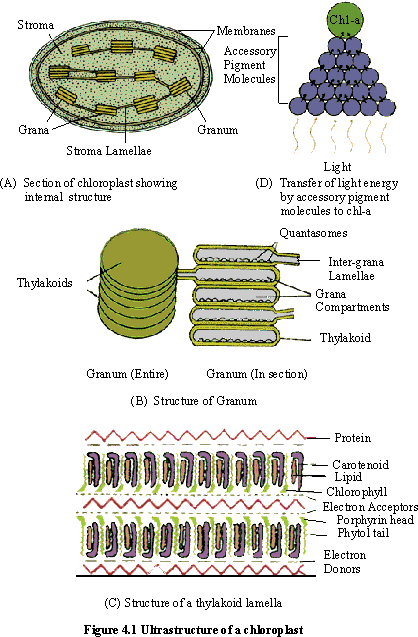|
PinkMonkey Online Study Guide-Biology
4.1 Chloroplasts
Chloroplasts are green plastids. These are the special protoplasmic organelles present only in the green cells of plants. Chloroplasts act as photosynthetic apparatus. The entire process of photosynthesis is completed in each chloroplast. Hence these are the site of photosynthetic reactions. Leaves are specialized photosynthetic organs and hence, they contain the maximum number of chloroplasts in their mesophyll cells. Moreover the morphology and the anatomy of leaves are most helpful during photosynthesis for :
(i) getting maximum absorption of sunlight,
(ii) providing steady exchange of water to green
cells, and
(iii) allowing free
exchange of carbon dioxide and oxygen.
Ultrastructure of chloroplast
The chloroplasts in higher plants are microscopic and
mostly oval, spherical or discoid. Each chloroplast is bounded by two
smooth and selectively permeable cytoplasmic membranes with an inter-membrane
space. These are composed of
lipo-protein subunits.
 Click here to enlarge
Click here to enlarge
The internal space of the chloroplast is filled with
a colorless hydrophilic matrix called the stroma. A number of grana
are suspended in the stroma. Each granum is a stack (compact bundle) of
thylakoids. These are membrane-bound, flattened, disc-shaped vesicles.
The thylakoid membranes are called grana lamellae. All grana are
connected to one another by stroma lamellae (i.e. inter-grana lamellae
or frets). The internal space of each thylakoid is called a fret channel.
The thylakoid lamellae are composed of alternating layers
of lipids and aqueous proteins. There is a layer of chlorophyll and carotenoid
molecules situated between the protein and lipid layers. The chlorophyll
molecules are arranged in such a way that their hydrophilic heads extend
into the aqueous protein layer while the lipophilic tails are embedded
in the lipid layer. The pigments are organized into numerous photosynthetic
units called quantasomes. Each quantasome contains about 230 to
300 chlorophyll molecules. Quantasomes are capable of trapping light energy
and converting it into chemical energy (ATP) during the photochemical
reactions (light reaction) of photosynthesis. The grana also contain various
co-enzymes and electron acceptors necessary for the process. Hence, grana
are the site of the light reactions (phase-I) in photosynthesis.
The stroma contains various enzymes required for the
dark reaction( i.e., the biochemical reactions involving the reduction
of carbon dioxide to form carbohydrates). Hence, stroma is the site of
the dark reactions (phase-II) of photosynthesis. The "dark
reactions" do not directly require light, but they do require energy
produced from light during the light reactions.
The grana thylakoids and the stroma lamellae together
form an intricate internal membrane system in the chloroplast. This system
is derived from the inner limiting membrane during the development of
chloroplast.
Pigments in photosynthesis : The most common photosynthetc
pigments present in higher plants and green algae are:
(i) Chlorophyll-a (blue-green) = C55H72O5N4Mg
(ii) Chlorophyll-b (yellow-green) = C55H70O6N4Mg
(iii) Carotenoids - Carotenes (orange-red) = C40 H56
(iv) Xanthophylls (yellow) = C40H56O2
For photosynthesis, these pigments can absorb and use light belonging to the visible spectrum only.
Both chlorophyll-a and chlorophyll-b show maximum light
absorption in the blue-violet and in the red regions of the visible range
of wavelengths of light.
Carotenoids absorb light in the blue and blue-green regions. They also protect the chlorophyll from undergoing photo-oxidation when exposed to very high intensity light.
Chlorophyll-a is the essential pigment in photosynthesis, because only chlorophyll-a can utilize the absorbed light energy for the synthesis of chemical energy ATP. Other pigments act as accessory pigments. They collect the light energy and transfer it to chlorophyll-a for photosynthesis.
Thylakoids in prokaryotes : In prokaryotes like
cyanobacteria, purple bacteria, etc., thylakoids are present but they
lie naked in the cytoplasm. Chloroplasts are absent. In prokaryotes, pigments
are distributed uniformly on or in the lamellae.
|